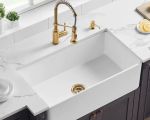- 1-Preparing-for-Showerhead-Installation
- 2-Removing-the-Old-Showerhead
- 3-Checking-and-Prepping-the-Plumbing-Connection
- 4-Installing-the-New-Showerhead
- 5-Testing-for-Leaks-and-Adjustments
- 6-Tips-for-Maintenance-and-Troubleshooting
1. Preparing for Showerhead Installation
Knowing how to install a new showerhead in the bathroom starts with proper preparation. Before you begin, gather the necessary tools such as an adjustable wrench, plumber’s tape (Teflon tape), and a cloth or rag to protect fittings from scratches. Choose a new showerhead that fits your bathroom plumbing and suits your style preferences, whether it’s a rainfall, handheld, or multi-function model.
Shutting off the water supply to the shower is generally not required because most shower valves control flow, but it’s wise to test water flow and ensure the faucet is turned off before removing the old showerhead. This step avoids unwanted water spraying and makes installation smoother.
Preparing your workspace by clearing the area and placing a towel in the tub or shower floor prevents any dropped parts from causing damage. Proper preparation sets the foundation for a stress-free installation process.
2. Removing the Old Showerhead
Removing the old showerhead is usually straightforward but may require some effort if it’s been in place for years. Use an adjustable wrench to loosen the connection by turning counterclockwise. Wrapping the wrench jaws with a cloth protects the fixture’s finish.
Some showerheads might unscrew by hand, especially if they were installed recently. If the old showerhead feels stuck due to mineral buildup or corrosion, applying a penetrating lubricant can help ease removal. Patience during this step prevents damage to the shower arm or plumbing behind it.
Once removed, clean the threads on the shower arm carefully to remove old plumber’s tape, mineral deposits, or debris. A clean surface ensures a tight, leak-free seal for the new showerhead.
3. Checking and Prepping the Plumbing Connection
Before installing the new showerhead, check the shower arm for any signs of damage or wear, such as cracks or stripped threads. Replacing a damaged shower arm may be necessary for a secure fit and proper water flow.
Wrap new plumber’s tape around the threads of the shower arm clockwise, covering them 2-3 times to create a waterproof seal. The tape prevents leaks and makes it easier to tighten the new showerhead securely.
This step is crucial for maintaining the longevity of the installation and avoiding drips that can waste water and cause damage over time.
4. Installing the New Showerhead
To install your new showerhead, simply screw it onto the shower arm by hand, turning clockwise. Once hand-tight, use the adjustable wrench with a cloth to gently tighten it further, but avoid over-tightening which can crack fittings or strip threads.
Depending on the model, some showerheads come with additional washers or seals—make sure to install these as directed by the manufacturer’s instructions. Multi-function showerheads or handheld sets might require assembling the hose and mounting brackets.
Following the product-specific directions ensures optimal performance and a snug fit, delivering the best water flow and spray pattern.
5. Testing for Leaks and Adjustments
After installation, turn on the water slowly and check for leaks at the connection points. If you notice drips or water spraying around the threads, tighten the showerhead a bit more or reapply plumber’s tape.
Test all the functions if your new showerhead offers adjustable spray patterns or handheld features. Adjusting the angle and position might enhance comfort and water coverage.
Monitoring for leaks and proper function immediately after installation helps avoid future plumbing issues and ensures a satisfying shower experience.
6. Tips for Maintenance and Troubleshooting
Regular maintenance keeps your new showerhead performing well. Cleaning mineral deposits by soaking the head in vinegar every few months can prevent clogging and maintain water pressure. Avoid harsh chemical cleaners that may damage finishes.
If water flow decreases or becomes uneven, check for clogs or debris inside the showerhead. Removing and rinsing internal components can often restore optimal performance.
For any complex issues, consulting professional plumbers or exploring resources from Improvement can provide expert solutions and product recommendations, ensuring your bathroom upgrade lasts for years.








